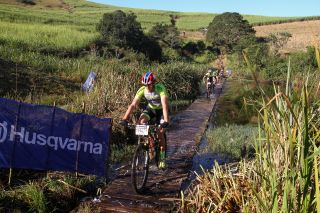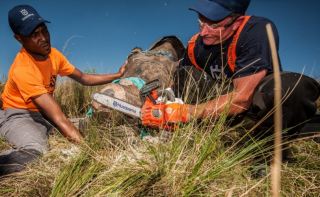Jessop's dream month continues with Husqvarna Mid-Illovo Classic MTB & Trail Run
SOUTH Africa U23 champion Julian Jessop continued his dream month when he beat off the challenge of Tyronne White in a dash for the line at the 60km mountain bike race at the Husqvarna Classic Mid-Illovo MTB Challenge and Trail Run on Sunday.
The 20-year-old Jessop - who is coming off a dream 12th position finish at the recent Absa Cape Epic and so claimed the prestigious African Jersey title with Matthys Beukes - and White approached the finish together. However the young PYGA Eurosteel rider had too much firepower for his more experienced challenger and powered across to line to win in a time of 2:32:08, two seconds ahead of White.
Quattro ROAG Series leader Andrew Johnson claimed third position just 29-seconds further back and his third position in Sunday's second leg of the series, combined with his win in the opening leg at Wartburg in February, ensures the Ballito resident holds top spot in the race for South Africa's richest prize for a mountain bike series.David Low and Brennan Anderson rounded out the top five.
In the women's 60km race, Christie Leigh Hearder made her first appearance at a Quattro ROAG Series event of the year and notched up a convincing five-minute win to put the pressure on series leader Andrea de Boer. De Boer was second and keeps a firm grasp on the series lead going into the third leg at Karkloof in May, but will be aware that Hearder is lurking.
One of the most intriguing dices of the day was the women's 40km Safire MTB that saw matric pupil Tiffany Keep edge out Frances Janse van Rensburg by two minutes, while schoolboy Travis Stedman was clear winner in the men's 40km race.In the trail runs, Derek Wasserfall cruised to victory with Thierry Pletinckx just over two minutes off the pace in the 16km Farmers Agri-Care race while Mark Mackenzie was third. Mackenzie's third, when combined with his third position in the opening leg, is enough to move him to the top of the standings in the Quattro ROAG Series.
Sarah Gray enjoyed a two-minute win in the women's 16km trail run with Megan Wassung recording her second runner-up spot in two races after she was edged out by Wendy Mills at Wartburg. The two runner-up finishes are just enough to edge her to the top of the Quattro ROAG Series leaderboard, but Mills, who was fourth on Sunday, is now just eight points behind on the log.
Jacqui Cochran, the marketing manager from Husqvarna, was full of praise for the Mid Illovo event which she has seen grow substantially in the time her company has been involved with the popular race."Husqvarna is proud and delighted to partner with the Mid Illovo community for the past eight years. It has been a joy and delight to watch the race grow, but still retain its community following and hands-on approach by the local residents of the farming community."This event is not just a commercial success, but has managed to keep its personality that it always has had."
Partnering up in KwaZulu-Natal to save rhinos
The beautiful 700ha Gwahumbe Game & Spa in Mid-Illovo, KwaZulu-Natal, is the latest private reserve to join the ranks of others which have dehorned their rhinos.
Its partnership with Husqvarna and Hilton veterinary surgeon Dr Ryan van Deventer will, hopefully, ensure the survival of the lodge’s last remaining male rhino, eight-year-old Vuyo – and finally allow the expansion of its herd.
Previously, said Gwahumbe Game & Spa director Shanon MacKenzie, “We were too anxious about Vuyo’s safety to allow him to be photographed, and we postponed adding to the herd because of the risk of poachers wanting their horns. We are extremely fond of him: he came here when he was just three. The decision to dehorn him was made with his survival and safety very much at the forefront of our minds.”
The devastating decline in the rhino population – and the poachers’ savagery– is just one of the issues on the agenda for this year’s CITES COP17 Conference* (24 September-5 October in Johannesburg). Sadly, the battle for the animal’s survival has been a losing one, until recently.
A local rhino-dehorning campaign, using Husqvarna outdoor power products, is proving highly successful in the bid to save these beautiful animals from poachers. In KwaZulu-Natal, particularly, the practice is gaining momentum, with increasing numbers of private game reserves voting for this option. The process was first used to help reduce poaching pressure in Zimbabwe in the 1980s. When rhinos are dehorned professionally, the horn is taken above the growth layer of the skin. Rhino horn is like a fingernail: you can cut it or trim it without stopping continued growth. But poachers brutally uproot the entire horn from its base under the skin in the bone.
Vet Dr Ryan van Deventer started working on the dehorning project a year ago in various KwaZulu-Natal areas, including, more recently, at the popular Gwahumbe Game & Spa. “Before dehorning, many rhino owners used ankle bracelets and horn transmitters for monitoring purposes,” he said.
“Although some of them are still resistant to dehorning, as the poaching problem escalates more and more reserves are realising they need to minimise the risk to the animals. It’s not a total solution to the problem but merely part of a holistic plan to try to prevent poaching.”
The Husqvarna Group, a global frontrunner in the manufacture of forest, agricultural and garden power products, has provided Van Deventer with a battery chainsaw and a petrol one – the petrol saw for the initial cutting, and the battery saw for the finer trimming. Some vets who work with rhinos are also relying on Husqvarna’s battery blowers to keep the rhino cool during the dehorning process. Battery products are fuel free so produce no harmful emissions. They are also quieter than their petrol equivalents and lower noise levels mean less anxiety for the sedated animal.
“The Husqvarna chainsaw is quicker than an oscillating saw,” said Van Deventer. “Once the animal is immobilised and stable, the procedure takes about 20-30 minutes.”
He said the Husqvarna blower played a vital role in keeping the rhino’s core body temperature down, which was particularly important during the procedure, especially in the hotter seasons. “There is always a risk with anaesthesia, and added to this is that white rhinos are particularly sensitive to the opioids. So we want to perform the dehorning as efficiently and quickly as possible.”
He said the recommended method to reduce poaching risk was to remove the horn as low to the base as possible, in addition to removing the side walls of the horn. This just leaves a small rounded bump of horn, reducing the poaching risk to the animal.”
Horns do grow back with time, but the rate depends on nutrition. “Animals receiving a lot of supplementary feeding have faster horn growth, so dehorning every 15-24 months is a good guide. But saying that, it’s not good enough to merely dehorn and expect there to be no poaching threat: you must ensure other checks are also in place.”
The plight of the rhino has gained international attention, and around the globe, various campaigns are creating awareness and raising funds to help conserve the animal.
Stefan Terblanche, former Springbok rugby player and CEO of the Rugby Legends, has added his voice to the chorus: “We must do all we can to reduce rhino poaching and I’m proud that we can help save the animal for future generations. It’s far better to have a dehorned rhino that is alive and that we can still enjoy seeing in our reserves.”
Husqvarna South Africa’s marketing manager Jacqui Cochran said: “We are extremely committed to this project, and thrilled that our diverse range of equipment is being used for a cause as worthwhile as saving the rhino.”
For more information about Husqvarna, visit www.husqvarna.co.za and www.gwahumbe.co.za
Ends



